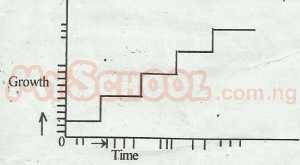Year :
2012
Title :
Biology
Exam :
WASSCE/WAEC MAY/JUNE
Paper 1 | Objectives
1 - 10 of 62 Questions
| # | Question | Ans |
|---|---|---|
| 1. |
The science of life is referred to as A. anatomy B. biology C. ecology D. phylogeny |
B |
| 2. |
The epidermis of a leaf is considered an example of a tissue because the cells A. allow sunlight to pass through. B. are covered by a waxy cuticle C. all possess a similar structure and function D. allow water to enter them by osmosis |
C |
| 3. |
The organism at the organ level of organisation of life is A. Euglena B. Spirogyra C. Ginger D. Tapeworm |
C |
| 4. |
The disadvantage of complexity of organisation in the higher organisms is that it leads to A. mutual interdependence between component cells B. internal structural specialization C. increased adaptation to environment D. slower rate of diffusion of oxygen to individual cells |
D |
| 5. |
In which of the following multicellular organisms is-interdependence of cells maintained? A. Spirogyra B. Volvox C. Eudorina D. Pandorina |
B |
| 6. |
Which of the following processes occurs in the second phase of meiosis? A. Homologous chromosomes separate B. Two daughtercells are formed C. Fertilization occurs D. Segregation of genes occurs |
A |
| 7. |
The muscle cell fluid of an athlete was tested immediately after a 1 O m race and was found to contain a high concentration of lactic acid. Explain what could have caused this. The A. athlete must have eaten food containing lactic acid just before the race B. Athlete must have injected lactic acid into his blood just before the race C. athletes muscle must have carried out anaerobic respiration during the race D. athlete must have inhaled lactic acid from the environment during the race |
C |
| 8. |
 The graph above represents the growth pattern of an animal. Which of the following groups of animals shows this pattern of growth? A. Cestoda B. Reptilia C. Amphibia D. Insecta |
D |
| 9. |
The pulmonary circulation involves movement of the blood to and from the A. brain B. Kidney C. Liver D. lungs |
D |
| 10. |
 Which of the individual is likely to be suffering from haemophilia? A. I B. II C. III D. IV |
D |
| 1. |
The science of life is referred to as A. anatomy B. biology C. ecology D. phylogeny |
B |
| 2. |
The epidermis of a leaf is considered an example of a tissue because the cells A. allow sunlight to pass through. B. are covered by a waxy cuticle C. all possess a similar structure and function D. allow water to enter them by osmosis |
C |
| 3. |
The organism at the organ level of organisation of life is A. Euglena B. Spirogyra C. Ginger D. Tapeworm |
C |
| 4. |
The disadvantage of complexity of organisation in the higher organisms is that it leads to A. mutual interdependence between component cells B. internal structural specialization C. increased adaptation to environment D. slower rate of diffusion of oxygen to individual cells |
D |
| 5. |
In which of the following multicellular organisms is-interdependence of cells maintained? A. Spirogyra B. Volvox C. Eudorina D. Pandorina |
B |
| 6. |
Which of the following processes occurs in the second phase of meiosis? A. Homologous chromosomes separate B. Two daughtercells are formed C. Fertilization occurs D. Segregation of genes occurs |
A |
| 7. |
The muscle cell fluid of an athlete was tested immediately after a 1 O m race and was found to contain a high concentration of lactic acid. Explain what could have caused this. The A. athlete must have eaten food containing lactic acid just before the race B. Athlete must have injected lactic acid into his blood just before the race C. athletes muscle must have carried out anaerobic respiration during the race D. athlete must have inhaled lactic acid from the environment during the race |
C |
| 8. |
 The graph above represents the growth pattern of an animal. Which of the following groups of animals shows this pattern of growth? A. Cestoda B. Reptilia C. Amphibia D. Insecta |
D |
| 9. |
The pulmonary circulation involves movement of the blood to and from the A. brain B. Kidney C. Liver D. lungs |
D |
| 10. |
 Which of the individual is likely to be suffering from haemophilia? A. I B. II C. III D. IV |
D |